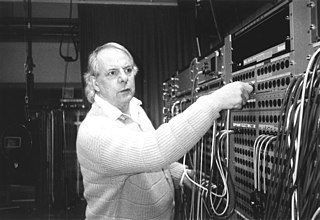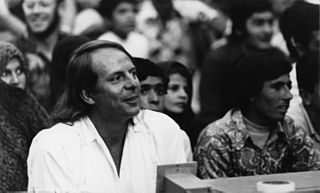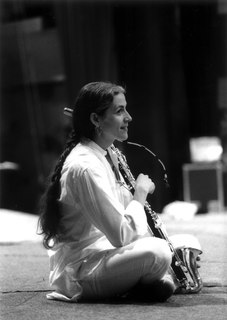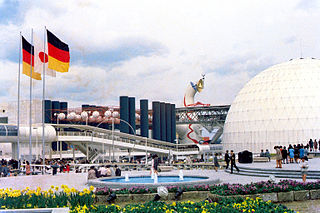Related Research Articles

Karlheinz Stockhausen was a German composer, widely acknowledged by critics as one of the most important but also controversial composers of the 20th and early 21st centuries. A critic calls him "one of the great visionaries of 20th-century music". He is known for his groundbreaking work in electronic music, for introducing controlled chance into serial composition, and for musical spatialization.

In music, tape loops are loops of magnetic tape used to create repetitive, rhythmic musical patterns or dense layers of sound when played on a tape recorder. Originating in the 1940s with the work of Pierre Schaeffer, they were used among contemporary composers of 1950s and 1960s, such as Éliane Radigue, Steve Reich, Terry Riley, and Karlheinz Stockhausen, who used them to create phase patterns, rhythms, textures, and timbres. Popular music authors of 1960s and 1970s, particularly in psychedelic, progressive and ambient genres, used tape loops to accompany their music with innovative sound effects. In the 1980s, analog audio and tape loops with it gave way to digital audio and application of computers to generate and process sound.

Vinko Globokar is a French-Slovenian avant-garde composer and trombonist.

Aus den sieben Tagen is a collection of 15 text compositions by Karlheinz Stockhausen, composed in May 1968, in reaction to a personal crisis, and characterized as "Intuitive music"—music produced primarily from the intuition rather than the intellect of the performer(s). It is Work Number 26 in the composer's catalog of works.

Tierkreis (1974–75) is a musical composition by the German composer Karlheinz Stockhausen. The title is the German word for Zodiac, and the composition consists of twelve melodies, each representing one sign of the zodiac.

Mikrophonie is the title given by Karlheinz Stockhausen to two of his compositions, written in 1964 and 1965, in which "normally inaudible vibrations. .. are made audible by an active process of sound detection ; the microphone is used actively as a musical instrument, in contrast to its former passive function of reproducing sounds as faithfully as possible".

Hymnen is an electronic and concrete work, with optional live performers, by Karlheinz Stockhausen, composed in 1966–67, and elaborated in 1969. In the composer's catalog of works, it is "Nr. 22".

In Freundschaft is a composition by Karlheinz Stockhausen, number 46 in his catalogue of works, which is playable on a wide variety of solo instruments. It was first performed on a clarinet on 28 July 1977.
Carré (Square) for four orchestras and four choirs (1959–60) is a composition by the German composer Karlheinz Stockhausen, and is Work Number 10 in the composer's catalog of works.
Adieufür Wolfgang Sebastian Meyer is a composition for wind quintet by Karlheinz Stockhausen composed in 1966. It is Number 21 in the composer's catalog of works, and the second of Stockhausen's three wind quintets.

Spiral, for a soloist with a shortwave receiver, is a composition by Karlheinz Stockhausen, written in 1968. It is Number 27 in the catalogue of the composer's works.
Studie II is an electronic music composition by Karlheinz Stockhausen from the year 1954 and, together with his Studie I, comprises his work number ("opus") 3. It is serially organized on all musical levels and was the first published score of electronic music.
Prozession (Procession), for tamtam, viola, electronium, piano, microphones, filters, and potentiometers, is a composition by Karlheinz Stockhausen, written in 1967. It is Number 23 in the catalogue of the composer’s works.

Punkte (Points) is an orchestral composition by Karlheinz Stockhausen, given the work number ½ in his catalogue of works.

Oktophonie (Octophony) is a 1991 octophonic electronic-music composition by Karlheinz Stockhausen. A component layer of act 2 of the opera Dienstag aus Licht, it may also be performed as an independent composition. It has a duration of 69 minutes.

Expo, for three performers with shortwave radio receivers and a sound projectionist, is a composition by Karlheinz Stockhausen, written in 1969–70. It is Number 31 in the catalogue of the composer's works.
Drei Lieder, for alto voice and chamber orchestra, is a song cycle by Karlheinz Stockhausen, written while he was still a conservatory student in 1950. In the composer's catalogue of works, it bears the number 1/10.

Europa-Gruss is a composition by Karlheinz Stockhausen for wind ensemble with optional synthesizers, and is assigned Number 72 in the composer's catalogue of works. It has a duration of about twelve-and-a-half minutes.

Musik für ein Haus is a group-composition project devised by Karlheinz Stockhausen for the 1968 Darmstädter Ferienkurse. Fourteen composers and twelve instrumentalists participated, with the resulting performance lasting four hours. It was not regarded by Stockhausen as a composition belonging solely to himself, and therefore was not assigned a number in his catalog of works.
Michael Svoboda is an American composer and trombonist who lives and works in Switzerland.
References
- Frisius, Rudolf. 2008. Karlheinz Stockhausen II: Die Werke 1950–1977; Gespräch mit Karlheinz Stockhausen, "Es geht aufwärts". Mainz, London, Berlin, Madrid, New York, Paris, Prague, Tokyo, Toronto: Schott Musik International. ISBN 978-3-7957-0249-6.
- Harvey, Jonathan. 1975. The Music of Stockhausen: An Introduction. Berkeley and Los Angeles: University of California Press. ISBN 0520023110.
- Herbort, Heinz Josef. 1987. "Klänge jede Menge: Neue Namen, neue Initiativen, neue Hoffnungen—aber alte Strukturen". Die Zeit, no. 44 (23 October).
- Kurtz, Michael. 1992. Stockhausen: A Biography, translated by Richard Toop. London and Boston: Faber and Faber. ISBN 0571143237 (cloth) ISBN 0-571-17146-X (pbk).
- Maconie, Robin. 2005. Other Planets: The Music of Karlheinz Stockhausen. Lanham, Maryland, Toronto, Oxford: The Scarecrow Press, Inc. ISBN 0-8108-5356-6.
- Mann, William. 1969. "Palimp—What?" The Times (1 August): 9.
- Sadie, Stanley. 1968. "Musicianship in New Guises". (6 December): 17.
- Sluchin, Benny. 2000. "A Computer-Assisted Version of Stockhausen's Solo for a Melody Instrument with Feedback". Computer Music Journal 24, no. 2 (Summer): 39–46.
- Sparnaay, Harry. 2011. "The Bass Clarinet: A Personal History". Barcelona: Periferia. ISBN 9788493884505.
- Stockhausen, Karlheinz. 1969. Solo, für Melodie-Instrument mit Rückkopplung, Nr. 19 (score). Vienna: Universal-Edition.
- Stockhausen, Karlheinz. 1971. "Solo für Melodie-Instrument mit Rückkopplung (1966)". In his Texte zur Musik 3, edited by Dieter Schnebel, 85–91. DuMont Dokumente. Cologne: Verlag M. DuMont Schauberg. ISBN 3-7701-0493-5.
- Stockhausen, Karlheinz. 2002. "Solo (1965/66) Version für Trompete mit Rückkopplung (Dauer ca. 15½ Min.)" / "Solo (1965/66) Version for Trumpet with Feedback (Duration ca. 15½ Minutes)". Programm zu den Interpretations- und Kompositionskursen und Konzerten der Musik von Stockhausen 27. Juli bis 4. August 2002 in Kürten / Programme for the Interpretation and Composition Courses and Concerts of the Music of Stockhausen July 27th to August 4th 2002 in Kuerten, English translations by Suzanne Stephens, 23–24, 50–51. Kürten: Stockhausen-Verlag.
- Stockhausen, Karlheinz. 2009. Kompositorische Grundlagen Neuer Musik: Sechs Seminare für die Darmstädter Ferienkurse 1970, edited by Imke Misch. Kürten: Stockhausen-Stiftung für Musik. ISBN 978-3-00-027313-1.